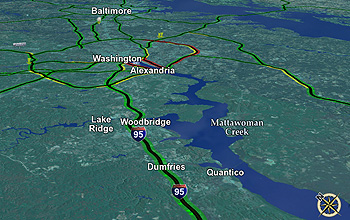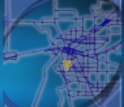News Release 05-032
Powerful Tool Crunches Commutes
Software crafts alternate routes for troubled commuters, predicts best time to hit the road

BeatTheTraffic.com provides real-time traffic data to commuters in 45 U.S. cities.
August 29, 2007
This material is available primarily for archival purposes. Telephone numbers or other contact information may be out of date; please see current contact information at media contacts.
(Editor's note: An earlier version of this release was first published on March 8, 2005.)
As the holidays approach and travelers hit the roads, traffic congestion becomes a hot topic around the country, even in places where rush hour is not very rushed at all.
Web sites for travelers are nothing new, but researchers in Sunnyvale, Calif., have developed an advanced system with a twist: in addition to tracking traffic congestion, the program crunches data from 14,000 sensors, in some cases every 30 seconds, to decipher evolving rush-hour patterns.
The end result is www.BeatTheTraffic.com, a tool that tells commuters how long they can expect to sit in their cars, which shortcuts will get them home faster that day, and even the best time to leave the home or office.
The tool is now available to commuters in 45 U.S. cities, with the heavily-congested Washington, D.C., metropolitan area just now coming online.
Tied to a statistical database that tracks how traffic conditions develop--over the course of a "rush hour," for example--the software suggests a commute based on congestion that may arise, not traffic status at the time of departure. Based on such statistics, the researchers have found that many commuters can save more time by altering their departure time than they would using mass transit.
In use for more than a year in states from Illinois to Alaska, www.BeatTheTraffic.com is user-tailored down to the scale of individual roads--a result of the vast, yet disparate, government data sources driving the software.
Developed by Triangle Software with the support of NSF's Small Business Innovation Research (SBIR) program, the tool is currently serving about 35,000 commuters, with the potential to help millions through coordination with local news media.
"By providing personalized traffic information on any number of routes or alternate routes straight to mobile phones or other text messaging devices, we try to save users time and aggravation," said Andre Gueziec, lead researcher on the project.
The Web site interface includes a base map of all roads, with average traffic speed and any obstacles--such as accidents or construction--mapped to each of 32,000,000 road segments. The software feeds this data to the routing engine, which can toggle travel options to find the quickest possible trip under real-time conditions.
Routes are personalized, so a user can continually track status on a number of regular paths, such as "home to grocery" or "office to gym," all of which are continuously recomputed to reflect new problems that may arise.
The researchers are close to releasing a new application that may eventually combine the accumulating road data with weather and holiday traffic information to generate seven-day forecasts for travel. The tool is particularly useful for travelers heading out of town, or those pondering relocation who want to better gauge their new commute before making the decision to move.
"BeatTheTraffic.com is better at exploiting live traffic data from transportation departments and law enforcement than any previous system," says Gueziec. "The site works similarly to a real-time 'Google,'" he adds, "finding specialized data for road conditions amidst a rapidly changing map."
The improvements are driven by a number of new developments, including the developers' powerful database-driven personalization engine, flexible routing engine, and efficient archiving and retrieval system.
The system already sends a text message to cell phones and other wireless devices when a route is experiencing a substantial delay, and the researchers are now exploring ways to integrate this function with car navigation systems.
NSF SBIR Phase II Award: Animated Real-Time Road Traffic Visualization for Broadcast and the Internet: http://www.nsf.gov/awardsearch/showAward.do?AwardNumber=0349460
The press release announcing the new D.C. component can be seen at: http://www.beatthetraffic.com/images/articles/BTTPressRelease20070731.htm
-NSF-
-
View Video
News10 in Sacramento is already using BeatTheTraffic to aid traffic reporting.
Credit and Larger Version -
Traffic congestion is a familiar sight.
Credit and Larger Version -
View Video
TV-ready www.BeatTheTraffic.com update of traffic conditions in Sacramento
Credit and Larger Version
Media Contacts
Joshua A. Chamot, NSF, (703) 292-8070, email: jchamot@nsf.gov
Program Contacts
Juan E. Figueroa, NSF, (703) 292-7054, email: jfiguero@nsf.gov
Principal Investigators
Andre Gueziec, Triangle Software, (408) 879-5805, email: pr@BeatTheTraffic.com
The U.S. National Science Foundation propels the nation forward by advancing fundamental research in all fields of science and engineering. NSF supports research and people by providing facilities, instruments and funding to support their ingenuity and sustain the U.S. as a global leader in research and innovation. With a fiscal year 2023 budget of $9.5 billion, NSF funds reach all 50 states through grants to nearly 2,000 colleges, universities and institutions. Each year, NSF receives more than 40,000 competitive proposals and makes about 11,000 new awards. Those awards include support for cooperative research with industry, Arctic and Antarctic research and operations, and U.S. participation in international scientific efforts.
Connect with us online
NSF website: nsf.gov
NSF News: nsf.gov/news
For News Media: nsf.gov/news/newsroom
Statistics: nsf.gov/statistics/
Awards database: nsf.gov/awardsearch/
Follow us on social
Twitter: twitter.com/NSF
Facebook: facebook.com/US.NSF
Instagram: instagram.com/nsfgov



